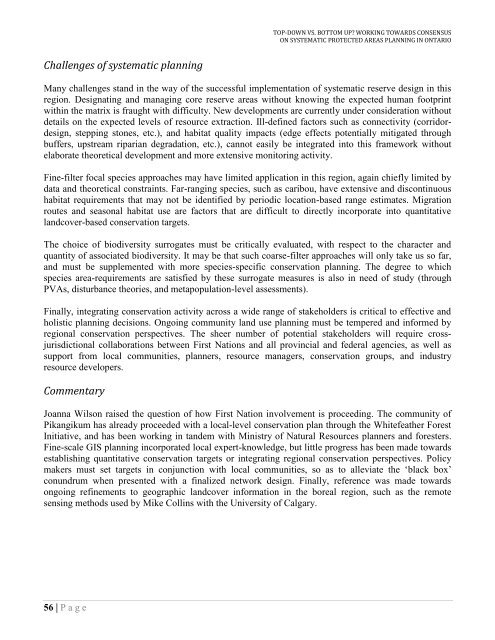Top-Down vs. Bottom Up: Working Towards Consensus ... - CASIOPA
Top-Down vs. Bottom Up: Working Towards Consensus ... - CASIOPA
Top-Down vs. Bottom Up: Working Towards Consensus ... - CASIOPA
- No tags were found...
You also want an ePaper? Increase the reach of your titles
YUMPU automatically turns print PDFs into web optimized ePapers that Google loves.
TOP-DOWN VS. BOTTOM UP? WORKING TOWARDS CONSENSUSON SYSTEMATIC PROTECTED AREAS PLANNING IN ONTARIOChallenges of systematic planningMany challenges stand in the way of the successful implementation of systematic reserve design in thisregion. Designating and managing core reserve areas without knowing the expected human footprintwithin the matrix is fraught with difficulty. New developments are currently under consideration withoutdetails on the expected levels of resource extraction. Ill-defined factors such as connectivity (corridordesign,stepping stones, etc.), and habitat quality impacts (edge effects potentially mitigated throughbuffers, upstream riparian degradation, etc.), cannot easily be integrated into this framework withoutelaborate theoretical development and more extensive monitoring activity.Fine-filter focal species approaches may have limited application in this region, again chiefly limited bydata and theoretical constraints. Far-ranging species, such as caribou, have extensive and discontinuoushabitat requirements that may not be identified by periodic location-based range estimates. Migrationroutes and seasonal habitat use are factors that are difficult to directly incorporate into quantitativelandcover-based conservation targets.The choice of biodiversity surrogates must be critically evaluated, with respect to the character andquantity of associated biodiversity. It may be that such coarse-filter approaches will only take us so far,and must be supplemented with more species-specific conservation planning. The degree to whichspecies area-requirements are satisfied by these surrogate measures is also in need of study (throughPVAs, disturbance theories, and metapopulation-level assessments).Finally, integrating conservation activity across a wide range of stakeholders is critical to effective andholistic planning decisions. Ongoing community land use planning must be tempered and informed byregional conservation perspectives. The sheer number of potential stakeholders will require crossjurisdictionalcollaborations between First Nations and all provincial and federal agencies, as well assupport from local communities, planners, resource managers, conservation groups, and industryresource developers.CommentaryJoanna Wilson raised the question of how First Nation involvement is proceeding. The community ofPikangikum has already proceeded with a local-level conservation plan through the Whitefeather ForestInitiative, and has been working in tandem with Ministry of Natural Resources planners and foresters.Fine-scale GIS planning incorporated local expert-knowledge, but little progress has been made towardsestablishing quantitative conservation targets or integrating regional conservation perspectives. Policymakers must set targets in conjunction with local communities, so as to alleviate the „black box‟conundrum when presented with a finalized network design. Finally, reference was made towardsongoing refinements to geographic landcover information in the boreal region, such as the remotesensing methods used by Mike Collins with the University of Calgary.56 | P a g e


